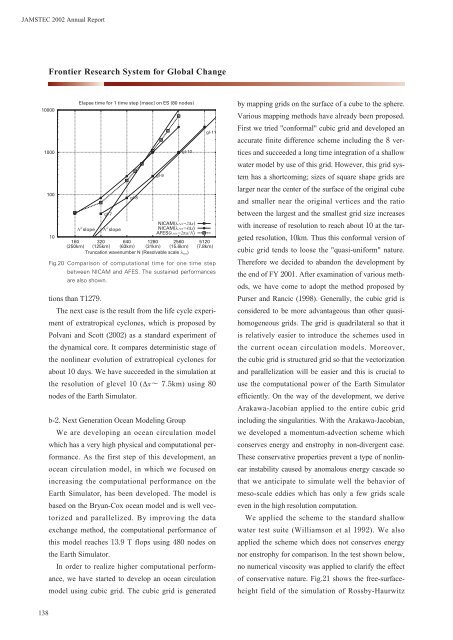Marine Ecosystems Research Department - jamstec japan agency ...
Marine Ecosystems Research Department - jamstec japan agency ...
Marine Ecosystems Research Department - jamstec japan agency ...
You also want an ePaper? Increase the reach of your titles
YUMPU automatically turns print PDFs into web optimized ePapers that Google loves.
JAMSTEC 2002 Annual Report<br />
Frontier <strong>Research</strong> System for Global Change<br />
10000<br />
1000<br />
100<br />
10<br />
160<br />
(250km)<br />
320<br />
(125km)<br />
640<br />
(63km)<br />
1280<br />
(31km)<br />
2560<br />
(15.6km)<br />
Truncation wavenumber N (Resolvable scale λ res)<br />
tions than T.<br />
Elapse time for 1 time step [msec] on ES (80 nodes)<br />
3<br />
N slope<br />
gl-7<br />
2<br />
N slope<br />
gl-8<br />
The next case is the result from the life cycle experiment<br />
of extratropical cyclones, which is proposed by<br />
Polvani and Scott () as a standard experiment of<br />
the dynamical core. It compares deterministic stage of<br />
the nonlinear evolution of extratropical cyclones for<br />
about days. We have succeeded in the simulation at<br />
the resolution of glevel (∆x .km) using <br />
nodes of the Earth Simulator.<br />
b-. Next Generation Ocean Modeling Group<br />
5120<br />
(7.8km)<br />
We are developing an ocean circulation model<br />
which has a very high physical and computational performance.<br />
As the first step of this development, an<br />
ocean circulation model, in which we focused on<br />
increasing the computational performance on the<br />
Earth Simulator, has been developed. The model is<br />
based on the Bryan-Cox ocean model and is well vectorized<br />
and parallelized. By improving the data<br />
exchange method, the computational performance of<br />
this model reaches . T flops using nodes on<br />
the Earth Simulator.<br />
In order to realize higher computational performance,<br />
we have started to develop an ocean circulation<br />
model using cubic grid. The cubic grid is generated<br />
gl-9<br />
gl-10<br />
NICAM(λ res=2∆x)<br />
NICAM(λ res=4∆x)<br />
AFES(λ res=2πa/ N)<br />
gl-11<br />
Fig.20 Comparison of computational time for one time step<br />
between NICAM and AFES. The sustained performances<br />
are also shown.<br />
by mapping grids on the surface of a cube to the sphere.<br />
Various mapping methods have already been proposed.<br />
First we tried "conformal" cubic grid and developed an<br />
accurate finite difference scheme including the vertices<br />
and succeeded a long time integration of a shallow<br />
water model by use of this grid. However, this grid system<br />
has a shortcoming; sizes of square shape grids are<br />
larger near the center of the surface of the original cube<br />
and smaller near the original vertices and the ratio<br />
between the largest and the smallest grid size increases<br />
with increase of resolution to reach about at the targeted<br />
resolution, km. Thus this conformal version of<br />
cubic grid tends to loose the "quasi-uniform" nature.<br />
Therefore we decided to abandon the development by<br />
the end of FY . After examination of various methods,<br />
we have come to adopt the method proposed by<br />
Purser and Rancic (). Generally, the cubic grid is<br />
considered to be more advantageous than other quasihomogeneous<br />
grids. The grid is quadrilateral so that it<br />
is relatively easier to introduce the schemes used in<br />
the current ocean circulation models. Moreover,<br />
the cubic grid is structured grid so that the vectorization<br />
and parallelization will be easier and this is crucial to<br />
use the computational power of the Earth Simulator<br />
efficiently. On the way of the development, we derive<br />
Arakawa-Jacobian applied to the entire cubic grid<br />
including the singularities. With the Arakawa-Jacobian,<br />
we developed a momentum-advection scheme which<br />
conserves energy and enstrophy in non-divergent case.<br />
These conservative properties prevent a type of nonlinear<br />
instability caused by anomalous energy cascade so<br />
that we anticipate to simulate well the behavior of<br />
meso-scale eddies which has only a few grids scale<br />
even in the high resolution computation.<br />
We applied the scheme to the standard shallow<br />
water test suite (Williamson et al ). We also<br />
applied the scheme which does not conserves energy<br />
nor enstrophy for comparison. In the test shown below,<br />
no numerical viscosity was applied to clarify the effect<br />
of conservative nature. Fig. shows the free-surfaceheight<br />
field of the simulation of Rossby-Haurwitz<br />
138
















